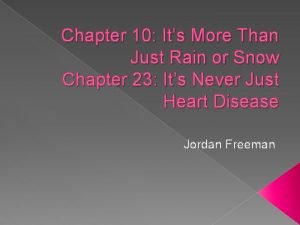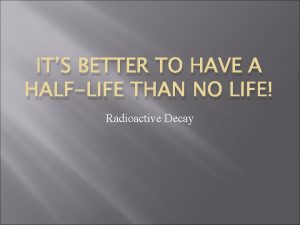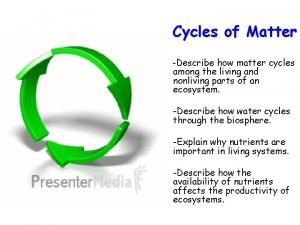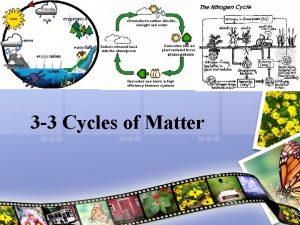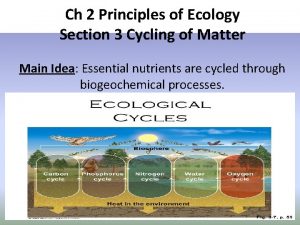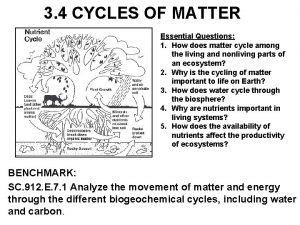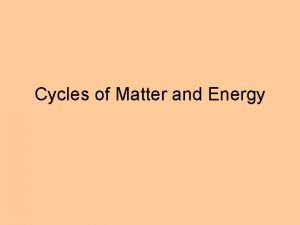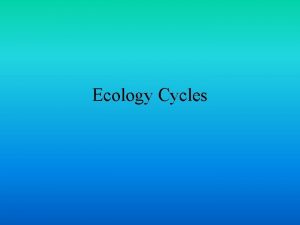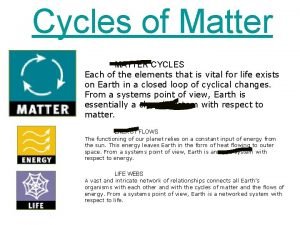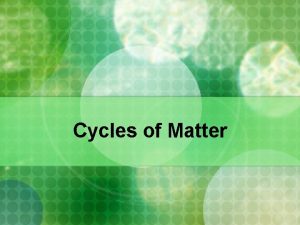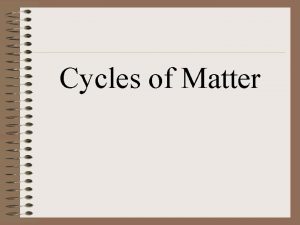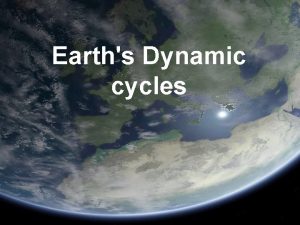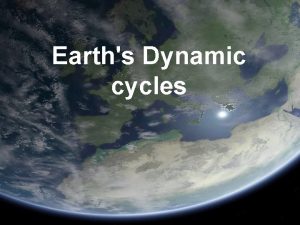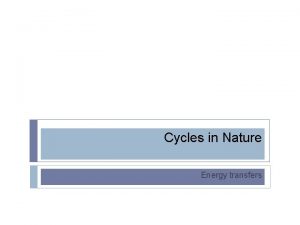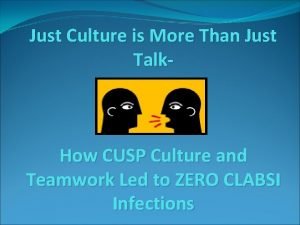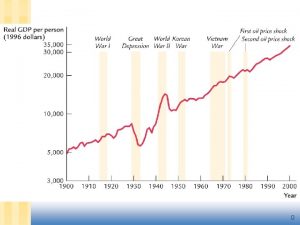Cycles of Matter More Than Just Energy All



















- Slides: 19

Cycles of Matter

More Than Just Energy • All living organisms need energy to survive, but they also need…. . 1. Water 2. Minerals 3. And other life sustaining compounds. • These additional necessities are referred to as nutrients

Nutrient Cycles • Every living organism needs nutrients to grow and carry out essential life functions. • Nutrients are passed between organisms and the environment through biogeochemical cycles.

Recycling In the Biosphere • Unlike the one way flow of energy (from sun/inorganic chemicals to producers & consumers), matter is recycled within and between ecosystems.

Biogeochemical Cycle • A cycle in which elements, chemical compounds, and other forms of matter are passed from one organism to another, and from one part of the biosphere to another. • Connects the biological, chemical, and geological aspects of the biosphere.

• Nutrients are often in short supply. • Recycling in necessary to keep ecosystems functioning. • Recycling prevents many chemicals from reaching toxic concentrations.

Water Cycle • All living things require H 20 to survive. • This H 20 is recycled throughout the atmosphere.


Carbon Cycle • Carbon is the key ingredient in all living organisms. • Carbon is found in the ocean, air, and in certain rocks. • Of all the carbon on the Earth, less than 1% actively circulates within the biosphere.

4 Diff types processes in the C cycle 1. Biological- ex. Photosynthesis, respiration, decomposition. 2. Geochemical- the release of CO 2 into the atmosphere by volcanoes. 3. Mixed biochemical processes- the burial of carbon rich remains of organisms, then the conversion of these organisms into coal and fossil fuels. 4. Human activity- mining, burning fossil fuels, etc.


Nitrogen Cycle • Nitrogen is used to make amino acids, which are used to make proteins. • N 2 gas makes up 78% of air. • NH 3 (ammonia), nitrate, & nitrite are found in organism waste.

Nitrogen Fixation • Nitrogen gas is the most abundant form of nitrogen. • Only certain types of bacteria can use this type of nitrogen. • They convert nitrogen gas into ammonia, nitrates, and nitrites. This is called nitrogen fixation.

• Once the bacteria “fix” the nitrogen, plants can use the nitrogen to make proteins. • Consumers can then eat the plants and obtain the proteins and the nitrogen. • Consumers die and are decomposed returning the N to the soil in the form of ammonium • Bacteria can now convert this N back into N gas using the process of denitrification


The Phosphorus Cycle • Phosphorus is essential to organisms because it helps forms important molecules like DNA and RNA • Most phosphorus exists in the form of inorganic phosphate. • Inorganic phosphate is released into the soil and water as sediments wear down.

• Phosphate, eventually enters the ocean, where it is used by marine organisms. • Some phosphate stays on land cycles between organisms and the soil. Plants bind the phosphates into organic compounds like proteins.


 Lirik lagu more more more we praise you
Lirik lagu more more more we praise you More more more i want more more more more we praise you
More more more i want more more more more we praise you All of you is more than enough for all of me
All of you is more than enough for all of me Software is more than just a
Software is more than just a More than just bingo
More than just bingo Math is more than just numbers
Math is more than just numbers It's more than just rain or snow
It's more than just rain or snow Thousands of possibilities get yours slogan
Thousands of possibilities get yours slogan Why is mass more useful than weight for measuring matter
Why is mass more useful than weight for measuring matter Er than more than
Er than more than 5730x5
5730x5 Greater than god more evil than the devil
Greater than god more evil than the devil Water cycles of matter
Water cycles of matter 3-3 cycles of matter
3-3 cycles of matter Lesson 2 cycles of matter answer key
Lesson 2 cycles of matter answer key Precipitation in the water cycle
Precipitation in the water cycle Energy naturally flows from warmer matter to cooler matter.
Energy naturally flows from warmer matter to cooler matter. Millionaire game rules
Millionaire game rules 5-1 changing households
5-1 changing households Did paris love juliet
Did paris love juliet






